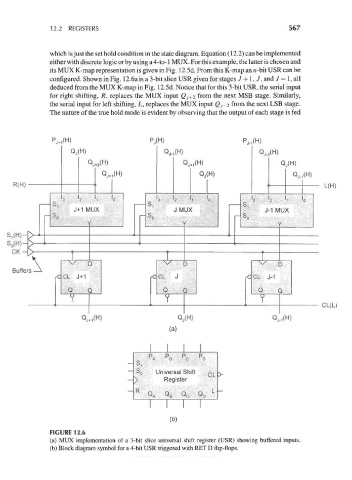Page 597 - Engineering Digital Design
P. 597
12.2 REGISTERS 567
which is just the set hold condition in the state diagram. Equation (12.2) can be implemented
either with discrete logic or by using a 4-to-1 MUX. For this example, the latter is chosen and
its MUX K-map representation is given in Fig. 12.5d. From this K-map an n-bit USR can be
configured. Shown in Fig. 12.6a is a 3-bit slice USR given for stages J + l, J, and J — 1, all
deduced from the MUX K-map in Fig. 12.5d. Notice that for this 3-bit USR, the serial input
for right shifting, R, replaces the MUX input Qj+2 from the next MSB stage. Similarly,
the serial input for left shifting, L, replaces the MUX input Qj-i from the next LSB stage.
The nature of the true hold mode is evident by observing that the output of each stage is fed
P i(H) Pj(H) Pj.^H)
J+
Qj(H) Qj-i(H) Qj. 2(H)
QJ <-2\ H) QJ+1 H) Qj(H)
Qj*i(H) Qj(H) Qj-i(H)
R(H) • •• L(H)
'
a 1 n 3 ? 1 ft 3 2 1 0
S. S. S.
J+1 MUX JMUX J-1 M\JX
S c S
0
° Y Y Y
,u\ i[x ,
1
X,
CK- X I !
* \/ D x/ D v D
Buffers — ^
-C CL J+1 rC CL J rC CL J-1
Q Q Q Q Q Q
Y Y Y
OL^L;
• n (\ }
Qj(H) Qj.^H)
(a)
P P P P
r
A r B C D
S 0 Universal Shift
> Register
R /~s i~\ r\
(b)
FIGURE 12.6
(a) MUX implementation of a 3-bit slice universal shift register (USR) showing buffered inputs.
(b) Block diagram symbol for a 4-bit USR triggered with RET D flip-flops.

